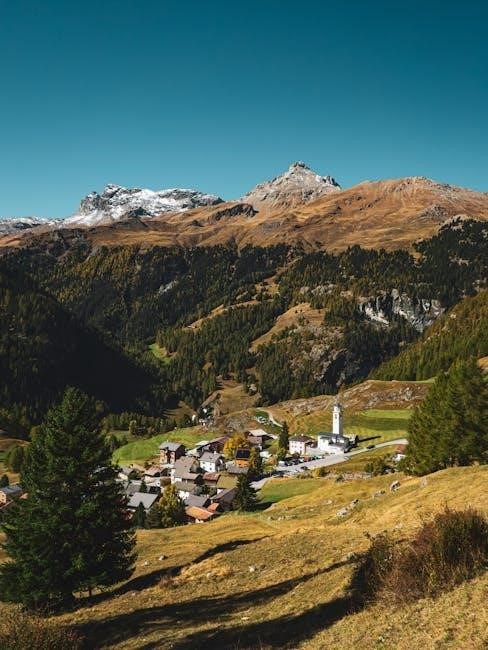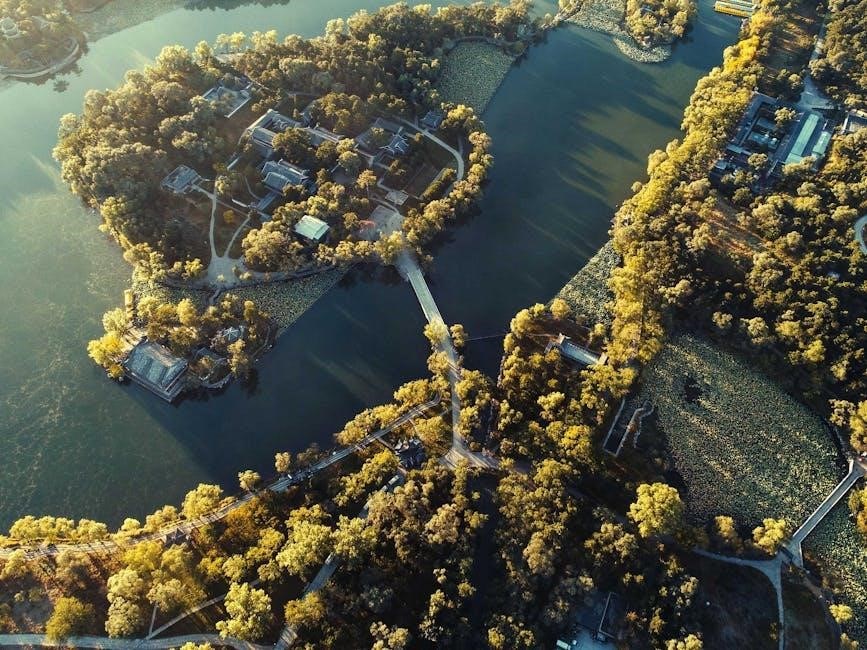Ursula K. Le Guin’s The Word for World is Forest (1972) is a powerful exploration of colonialism and environmentalism, set in a richly imagined universe. The novel, part of the Hainish Cycle, delves into themes of exploitation and resistance, resonating deeply with contemporary issues. Its title reflects the Athsheans’ profound connection to their forest world, emphasizing harmony with nature. The story’s raw intensity and lyrical prose make it a compelling read. PDF versions of the novel are widely available, offering readers easy access to this thought-provoking tale.
1.1 Overview of the Novel
The Word for World is Forest by Ursula K. Le Guin is a thought-provoking novel that explores themes of colonialism, environmentalism, and cultural conflict. Set on the planet Athshe, the story follows the clash between indigenous Athsheans and human colonizers (Terrans) who exploit the planet’s vast forests for resources. The novel delves into the consequences of imperialism and ecological destruction, highlighting the Athsheans’ deep connection to their natural world. Le Guin’s vivid storytelling and moral clarity make this work a compelling critique of human greed and a powerful call for environmental stewardship. The PDF version is widely accessible, ensuring its message reaches a broad audience.
1.2 Ursula K. Le Guin and Her Hainish Cycle
Ursula K. Le Guin’s The Word for World is Forest is part of her acclaimed Hainish Cycle, a series of novels and stories exploring anarchism, utopianism, and the complexities of human (and non-human) societies. Le Guin’s work often examines ecological balance, colonialism, and the ethical implications of power. The Hainish Cycle spans multiple worlds, offering a rich tapestry of interconnected narratives. The Word for World is Forest stands out for its raw critique of imperialism and environmental exploitation, reflecting Le Guin’s deep concern for the natural world. The novel’s themes resonate strongly in its PDF format, making it accessible to modern readers.
1.3 The Significance of the Title
The title The Word for World is Forest captures the essence of the Athsheans’ deep connection to their environment. For them, the forest is not just a landscape but a living entity, integral to their culture and spirituality. The title reflects the novel’s central theme of ecological harmony and the clash between nature-centric and exploitative worldviews. It also symbolizes the Athsheans’ unity and collective consciousness, which is tied to the forest. The title’s simplicity underscores the profound message of the novel, resonating deeply with readers in both print and PDF formats, highlighting the universal relevance of environmental stewardship.

Plot Summary
Set in a dystopian future, The Word for World is Forest explores human exploitation of planet Athshe for wood, sparking conflict with its peaceful inhabitants. The forest, central to Athshean culture, becomes a symbol of resistance against colonial destruction. Available in PDF, the novel vividly portrays ecological and societal clashes, highlighting the cost of imperialism and the enduring power of nature.
2;1 Setting: Planet Athshe and Its Inhabitants
Planet Athshe, a lush world covered in dense forests, is home to a peaceful, indigenous species. The Athsheans live in harmony with their environment, relying on the forest for sustenance and spirituality. Their society is deeply connected to nature, with a collective consciousness that enhances their unity. The arrival of Terrans, humans exploiting Athshe for its wood, disrupts this balance. The forest, central to Athshean culture, becomes a battleground between indigenous preservation and colonial exploitation. This clash of worlds highlights themes of environmentalism and colonialism, central to the novel’s narrative. The PDF version captures this vivid setting, immersing readers in Athshe’s unique ecosystem.
2.2 Human Colonization and Resource Exploitation
The novel depicts a dystopian future where humans, known as Terrans, colonize planet Athshe to exploit its vast forests for wood, a resource Earth has depleted. Driven by greed and disregard for the planet’s ecosystem, Terrans disrupt the delicate balance of Athshe’s environment. The indigenous Athsheans, who live in harmony with nature, face brutal exploitation and violence. The destruction of their forests threatens their way of life and cultural traditions. This colonization mirrors historical patterns of exploitation, highlighting themes of environmental degradation and the clash between industrial greed and natural harmony. The PDF version of the novel vividly portrays this ecological conflict.
2.3 Conflict Between Terrans and Athsheans
The conflict escalates as Terrans, driven by greed, disregard Athshean culture and ecology. Initial peaceful coexistence turns violent when Terrans exploit the forest, leading to the rape and murder of an Athshean woman. Selver, a wise Athshean leader, retaliates, sparking a guerrilla war. The Terrans, unprepared for resistance, respond with brutal force, destroying villages and slaughtering inhabitants. The Athsheans, though technologically inferior, use their deep connection to the forest to outmaneuver the Terrans. The conflict highlights themes of violence, cultural misunderstanding, and the clash between industrial and natural societies, ultimately leading to tragic consequences for both sides.
2.4 The Role of the Forest in the Story
The forest is central to the story, serving as both a character and a symbol. It is the lifeblood of the Athsheans, providing sustenance, shelter, and spiritual connection. The forest embodies their philosophy of harmony with nature, contrasting sharply with the Terrans’ exploitative mindset. Its vast, sentient network allows the Athsheans to communicate and resist oppression. The forest also symbolizes the clash between indigenous wisdom and colonial destruction. As the Terrans destroy it for resources, the forest becomes a battleground and a sanctuary, highlighting its dual role as a source of life and a weapon of resistance, ultimately shaping the novel’s ecological and cultural themes.
Themes and Motifs
The novel explores themes of environmentalism, colonialism, and cultural conflict, emphasizing the clash between indigenous harmony with nature and exploitative human expansion, while highlighting violence’s destructive impact.
3.1 Environmentalism and Ecological Destruction
The novel vividly portrays environmentalism through the clash between the indigenous Athsheans and the exploitative Terrans. The Athsheans live in harmony with their forest world, while the Terrans’ logging disrupts the ecological balance, leading to devastating consequences. This mirrors real-world environmental issues, highlighting the importance of preserving nature and respecting indigenous wisdom. The destruction of the forest serves as a powerful metaphor for humanity’s destructive tendencies and the urgent need for sustainable practices.
3.2 Colonialism and Imperialism
The novel critiques colonialism and imperialism through the Terrans’ exploitation of Athshe. The Terrans, driven by resource extraction, disregard the native Athsheans’ deep connection to their forest world. This reflects historical colonial patterns, where indigenous cultures are marginalized and their lands exploited. The novel highlights the ethical consequences of imperialism, such as cultural erasure and ecological destruction. Le Guin’s portrayal challenges readers to consider the moral implications of dominance and the importance of respecting indigenous sovereignty and environmental harmony.

3.3 Violence and Its Consequences
In “The Word for World is Forest,” violence escalates tensions between Terrans and Athsheans, leading to devastating consequences. Selver’s initial resistance turns violent after personal tragedy, mirroring the Terrans’ brutal exploitation. The novel illustrates how violence begets violence, causing irreparable harm to both sides. The Athsheans, traditionally peaceful, are forced into conflict, while the Terrans’ aggression accelerates ecological destruction. Le Guin highlights the moral and physical toll of violence, emphasizing its cyclical nature and the loss of innocence it entails for all parties involved.
3.4 Cultural Clash and Misunderstanding
The novel explores the profound cultural clash between the Terrans and Athsheans, rooted in their vastly different worldviews. The Terrans, driven by colonial ambitions, view the forest as a resource to exploit, while the Athsheans see it as a sacred, living entity. Misunderstandings arise from their contrasting perceptions of nature and humanity’s role within it. The Terrans fail to comprehend the Athsheans’ deep spiritual connection to the forest, leading to mistrust and hostility. This clash underscores the dangers of cultural insensitivity and the consequences of imposing one’s values on another civilization.

Character Analysis
The novel delves into complex characters, contrasting the violent Captain Davidson with the empathetic Lyubov and the wise Selver, exploring their roles in driving the story’s themes.
4.1 Captain Davidson: The Representation of Toxic Masculinity
Captain Davidson embodies toxic masculinity, exemplified by his aggressive dominance, disregard for indigenous life, and refusal to acknowledge the Athsheans’ sentience. His actions, driven by entitlement and a colonial mindset, highlight the destructive nature of unchecked power and patriarchal values. Davidson’s character serves as a critique of militaristic ideologies and the dehumanization of the “other,” making him a pivotal figure in the novel’s exploration of violence and exploitation. His presence underscores the clash between progress and preservation, symbolizing the darker aspects of human ambition. His role is central to the novel’s themes of colonialism and ecological decay.
4.2 Selver: The Leader of the Athshean Resistance
Selver, a wise and enigmatic Athshean, emerges as the leader of his people’s resistance against Terran exploitation. His deep connection to the forest and its collective consciousness grants him unique insight and strength. Selver’s leadership is marked by patience, strategic thinking, and a commitment to preserving his world’s harmony. He embodies the resilience of the Athsheans, navigating the complexities of cultural clash and violence. Through Selver, Le Guin illustrates the power of non-violent resistance and the importance of understanding between disparate worlds. His journey from individual to symbol of hope reflects the novel’s themes of unity and survival.
4.3 Lyubov: The Voice of Reason and Empathy
Dr. Raj Lyubov, a Terran xenologist, serves as a bridge between humans and Athsheans, advocating for understanding and peaceful coexistence. His deep empathy and respect for the forest world set him apart from the exploitative mindset of his fellow colonizers. Lyubov’s insights into the Athsheans’ collective consciousness highlight their profound connection to nature. Despite his efforts, his warnings are often ignored, leading to tragic consequences. Lyubov’s character represents the possibility of harmony between species, emphasizing the importance of cultural understanding and the devastating costs of its absence.
4.4 The Collective Consciousness of the Athsheans
The Athsheans possess a unique collective consciousness, enabling silent, shared thought among their kind. This communal mind fosters deep unity and harmony with their forest world. Their society, rooted in cooperation, contrasts sharply with the individualistic Terrans. The collective consciousness allows the Athsheans to act as one, making decisions for the greater good. This shared awareness also grants them profound wisdom and a connection to nature, central to their survival and resistance against exploitation. Their collective mind embodies their symbiotic relationship with the forest, emphasizing their holistic worldview and resilience in the face of external threats.

The Hainish Cycle Context
“The Word for World is Forest” is part of Ursula K. Le Guin’s Hainish Cycle, exploring themes of colonialism, environmentalism, and societal conflict within a shared universe.
5.1 The Hainish Universe and Its Novels
The Hainish Cycle, created by Ursula K. Le Guin, is a shared universe spanning multiple novels and short stories. It explores themes of anarchism, utopianism, and ecological balance across various planets. Notable works include The Left Hand of Darkness, The Dispossessed, and The Word for World is Forest. These stories are interconnected by a common history, with humanity originating from the planet Hain. The cycle delves into societal structures, colonialism, and ethical dilemmas, offering profound insights into human nature and the consequences of technological advancement. The Hainish Universe remains a cornerstone of science fiction literature.
5.2 The Role of “The Word for World is Forest” in the Cycle

In the Hainish Cycle, The Word for World is Forest stands as a powerful critique of colonialism and environmental exploitation. The novel explores the clash between indigenous harmony with nature and human imperialism, offering a unique perspective within the cycle. It highlights the ethical consequences of expansion and the importance of coexistence with ecosystems. As part of the Hainish Universe, it complements other works by Le Guin, emphasizing themes of ecological balance and the moral complexities of interplanetary relations. This novel serves as a poignant warning against the destruction of pristine worlds and their inhabitants.
5.3 Connections to Other Works by Le Guin
Ursula K. Le Guin’s The Word for World is Forest resonates with themes in her other works, such as The Left Hand of Darkness and The Dispossessed. These novels explore anarchism, utopianism, and the clash between nature and human ambition. The environmentalism and anti-colonial themes in The Word for World is Forest align with her broader critique of exploitation in the Hainish Cycle. Similarly, her Earthsea series reflects a deep connection to ecological balance and ethical responsibility. This novel, like her others, challenges readers to consider the consequences of human actions on fragile ecosystems and indigenous cultures.
Symbolism and Metaphors
The forest symbolizes life, interconnectedness, and indigenous wisdom, while fire represents destruction and colonial violence. Trees embody strength, and the moon reflects longing and isolation.
6.1 The Forest as a Symbol of Life and Unity
The forest in The Word for World is Forest is a profound symbol of life and unity, central to the Athsheans’ existence. It is not just their environment but a living, interconnected entity that sustains their culture, spirituality, and collective consciousness. The forest embodies their harmony with nature, showcasing a society where life and land are inseparable. This symbolism contrasts sharply with the Terrans’ exploitative worldview, highlighting the clash between indigenous wisdom and colonial destruction. The forest’s unity reflects the Athsheans’ deep connection to their world, emphasizing themes of ecological balance and communal living.
6.2 The Tree as a Symbol of Strength and Wisdom
In The Word for World is Forest, trees symbolize strength and wisdom, embodying the Athsheans’ deep spiritual connection to nature. The towering, ancient trees represent resilience and endurance, mirroring the Athsheans’ ability to thrive in harmony with their environment. Their wisdom is reflected in the trees’ silent endurance and the collective knowledge they hold, symbolizing the Athsheans’ ancestral wisdom and communal memory. This symbolism contrasts with the Terrans’ destructive exploitation, highlighting the clash between nature’s enduring strength and humanity’s short-sighted greed. The trees, thus, become a powerful metaphor for the enduring spirit of indigenous cultures and ecological harmony.
6.3 Fire as a Symbol of Destruction and Change
In The Word for World is Forest, fire serves as a potent symbol of destruction and transformation. The Terrans’ use of fire to clear the Athshean forests exemplifies its devastating power, causing irreversible harm to the ecosystem and displacing the native inhabitants. Fire also represents change, as it disrupts the delicate balance of the forest and forces the Athsheans to confront the consequences of human greed. The novel highlights fire’s dual nature: while it can bring renewal, in this context, it primarily signifies loss and the irreversible impact of human actions on the natural world.
6.4 The Moon as a Symbol of Distance and Longing
In The Word for World is Forest, the moon symbolizes distance and longing, serving as a constant reminder of the emotional and physical divide between the Terrans and Athsheans. For the Terrans, it represents a distant homeland they can never return to, evoking nostalgia and homesickness. For the Athsheans, it embodies the incomprehensible vastness of space and the alienness of human desires. The moon underscores the irreconcilable differences between the two cultures, highlighting the emotional toll of colonialism and the yearning for a lost connection to one’s roots.
Reception and Reviews
Ursula K. Le Guin’s The Word for World is Forest received critical acclaim for its profound exploration of colonialism and environmentalism. Readers praised its thought-provoking narrative and moral depth, while critics noted its relevance to contemporary issues. The novel’s PDF version has gained popularity for its accessibility, allowing a new generation to engage with Le Guin’s timeless themes. Its enduring popularity underscores its significance in the science fiction genre, resonating with readers seeking meaningful storytelling.
7.1 Critical Response to the Novel
Critics have praised The Word for World is Forest for its powerful commentary on colonialism and environmental degradation. The novel’s exploration of the clash between indigenous cultures and exploitative forces resonates deeply. Reviewers highlight Ursula K. Le Guin’s masterful storytelling and her ability to convey complex moral dilemmas. The PDF version has been particularly praised for its accessibility, allowing readers to engage with the story in a convenient format. Scholars note the novel’s relevance to contemporary ecological and political issues, solidifying its place as a seminal work in science fiction.

7.2 Reader Reactions and Popularity
Readers have widely embraced The Word for World is Forest, particularly in its PDF format, for its accessible and immersive storytelling. The novel’s themes of environmentalism and colonialism resonate strongly, sparking meaningful discussions. Many appreciate the portability of the PDF, allowing easy access to Le Guin’s profound narrative. The digital version has introduced the story to a broader audience, enhancing its popularity. Readers praise the depth of characters like Selver and Lyubov, and the emotional weight of the conflict between Terrans and Athsheans. The PDF’s convenience has further cemented the novel’s place as a cherished and thought-provoking read.
7.3 Comparisons with Other Works by Le Guin
Ursula K. Le Guin’s The Word for World is Forest shares thematic similarities with her other works, such as environmentalism and societal critique, seen in novels like The Left Hand of Darkness and The Dispossessed. However, the focus on colonial exploitation and ecological balance is more pronounced here. Le Guin’s signature exploration of morality and cultural clashes is evident, yet the novel’s emotional intensity and the Athsheans’ unique collective consciousness set it apart. Fans of her Hainish Cycle often highlight this book for its raw, haunting portrayal of imperialism and its resonance with contemporary issues, making it a standout in her bibliography.
7.4 The Novel’s Place in Science Fiction
The Word for World is Forest is a pivotal work in science fiction, blending ecological themes with social commentary. Le Guin’s exploration of colonialism, environmental destruction, and cultural conflict resonates deeply within the genre. The novel’s focus on morality and ethical dilemmas aligns with sci-fi’s tradition of questioning societal norms. Its unique blend of anthropology and philosophy sets it apart, offering a compelling critique of imperialism and capitalism. As part of the Hainish Cycle, it enriches Le Guin’s universe while standing as a powerful standalone narrative, influencing eco-fiction and anti-colonial literature in science fiction.
The Novel’s Message
Respecting indigenous cultures and nature is crucial. The novel warns against imperialism and exploitation, advocating for coexistence and mutual respect to preserve harmony with the environment.
8.1 Warning Against Environmental Exploitation
The novel serves as a stark warning against environmental exploitation, highlighting the devastating consequences of unchecked resource extraction. The Athsheans’ deep connection to their forest world contrasts sharply with the Terrans’ destructive logging practices. Le Guin illustrates how the exploitation of nature disrupts delicate ecosystems and erases indigenous cultures. The destruction of the forest not only threatens the planet’s biodiversity but also leads to the loss of ancient wisdom and spiritual harmony; This cautionary tale underscores the moral and environmental costs of prioritizing profit over sustainability and respect for the natural world.
8.2 Critique of Colonialism and Imperialism
Le Guin’s novel delivers a powerful critique of colonialism and imperialism, exploring the clash between the indigenous Athsheans and the exploitative Terran colonizers. The story vividly portrays how imperialist greed for resources leads to cultural erasure and ecological destruction. The Terrans’ disregard for the Athsheans’ way of life mirrors historical colonial atrocities, emphasizing the moral bankruptcy of conquest. Captain Davidson embodies the ruthless ambition of imperial powers, while Selver’s resistance highlights the resilience of indigenous cultures. The novel serves as a scathing indictment of imperialism’s destructive legacy and a call for respect of native sovereignty and cultural diversity.
8.3 The Importance of Cultural Understanding
The novel underscores the vital need for cultural understanding to prevent conflict and foster coexistence. The clash between the Athsheans and Terrans stems from profound misunderstandings of each other’s values and ways of life. The Athsheans’ deep connection to nature and collective consciousness contrasts sharply with the Terrans’ exploitative mindset. Lyubov’s efforts to bridge this gap highlight the transformative power of empathy and understanding. Le Guin advocates for mutual respect and the recognition of diverse worldviews as essential for peaceful resolution and the preservation of cultural richness in a universe marked by diversity and complexity.
8.4 The Power of Non-Violent Resistance
The novel illustrates the transformative power of non-violent resistance through Selver’s leadership. Initially, the Athsheans avoid direct confrontation, relying on their deep connection to the forest and collective consciousness to endure Terran oppression. However, when violence is unleashed, Selver embraces a balanced approach, blending non-violent strategies with necessary self-defense. This duality highlights the complexity of resistance, showing that non-violence, while morally compelling, may not always suffice against systemic brutality. Le Guin’s portrayal underscores the ethical dilemmas of resistance and the enduring strength of non-violent ideals in the face of overwhelming oppression.

The PDF Version
The PDF version of The Word for World is Forest offers a convenient and accessible way to read the novel digitally, preserving its powerful message and themes while providing an easy reading experience on various devices, making it a popular choice among modern readers who prefer e-books for their portability and ease of access to Le Guin’s timeless storytelling.
9.1 Availability of the Novel in PDF Format
The PDF version of The Word for World is Forest is widely available online, accessible through various platforms. Readers can purchase or download it from official sources like Amazon Kindle, Kobo, or the publisher’s website. Additionally, some libraries offer digital lending options. However, unauthorized free downloads from torrent sites or file-sharing platforms are illegal and unethical, undermining authors and publishers. The convenience of the PDF format has made it a popular choice, allowing readers to enjoy Ursula K. Le Guin’s profound story on devices like e-readers, tablets, or smartphones, ensuring accessibility and portability for modern readers while supporting lawful content distribution.
9.2 Reasons for Its Popularity in Digital Format
The PDF format of The Word for World is Forest has gained popularity due to its convenience and accessibility. Readers appreciate the ability to carry the novel on digital devices, making it easy to read on the go. The environmental themes of the book resonate with eco-conscious readers who prefer digital formats over physical copies. Additionally, the growing interest in Ursula K. Le Guin’s Hainish Cycle has driven demand for digital versions, allowing fans to explore her works seamlessly. The PDF format also ensures the text’s integrity, preserving the author’s intent and narrative style for a modern audience.
9.3 Ease of Access and Reading Experience
The PDF version of The Word for World is Forest offers an enhanced reading experience through its digital format. Readers can easily adjust font sizes, enabling comfortable reading on various devices. The text is searchable, making it simple to locate specific passages or themes. Additionally, digital bookmarks and highlighting features allow readers to engage deeply with the narrative. The portability of the PDF ensures that the novel can be accessed anywhere, providing flexibility for readers to immerse themselves in Le Guin’s thought-provoking story at their convenience. This accessibility enhances the overall reading experience.
9;4 Legal and Ethical Considerations
Obtaining a PDF of The Word for World is Forest legally ensures compliance with copyright laws, protecting the rights of authors and publishers. Piracy undermines the literary ecosystem, potentially harming future works. Ethically, supporting creators by purchasing or borrowing through legitimate channels promotes sustainability in publishing. Accessing the novel legally also guarantees quality and authenticity, avoiding risks associated with unauthorized downloads. Readers are encouraged to respect intellectual property and contribute to the ethical consumption of literature. This approach fosters a fair environment for authors and publishers to thrive.
The Word for World is Forest remains a powerful exploration of environmentalism, colonialism, and cultural clash, offering timeless lessons on coexistence and ethical responsibility.
10.1 Summary of Key Points
The PDF version of The Word for World is Forest offers a convenient and accessible reading experience, allowing readers to engage with Ursula K. Le Guin’s powerful narrative on environmentalism and colonialism. Its digital format ensures ease of access across devices, making it widely popular among modern readers. The novel’s themes of ecological balance and cultural understanding resonate deeply, while its inclusion in the Hainish Cycle highlights Le Guin’s visionary storytelling. Legal and ethical considerations remind readers to obtain the PDF from authorized sources to support the author’s legacy and intellectual property rights.
10.2 The Lasting Impact of the Novel
The Word for World is Forest has left a profound mark on science fiction and environmental literature, inspiring discussions on ecological preservation and colonial ethics. Its exploration of native resistance and human greed remains timeless, resonating with modern movements like climate fiction. The novel’s themes of harmony with nature and the consequences of exploitation have influenced eco-conscious storytelling. As part of the Hainish Cycle, it connects readers to Le Guin’s broader universe while standing as a powerful standalone critique of human ambition and the enduring spirit of indigenous cultures. Its influence continues to grow, shaping new generations of writers and readers alike.
10.3 Final Thoughts on “The Word for World is Forest”
The Word for World is Forest is a hauntingly beautiful exploration of colonialism, environmentalism, and the clash of cultures. Its profound themes resonate deeply, urging readers to reflect on humanity’s relationship with nature. The novel’s accessible PDF format has made it easier for modern audiences to engage with Le Guin’s timeless message. The forest, as a symbol of life and unity, reminds us of the consequences of exploitation and the importance of preserving harmony with the natural world. This novel remains a powerful and thought-provoking read, relevant even decades after its publication.
10.4 Recommendations for Further Reading

For readers captivated by The Word for World is Forest, further exploration of Ursula K. Le Guin’s works is highly recommended. Novels like The Left Hand of Darkness and The Dispossessed offer similar themes of societal critique and philosophical depth. Additionally, works by authors like N.K. Jemisin and Kim Stanley Robinson, who explore environmentalism and colonialism, provide complementary perspectives. These stories expand on the ideas presented in Le Guin’s novel, offering a richer understanding of science fiction’s ability to address pressing global issues. Exploring these texts enriches the reader’s appreciation for thought-provoking literature.
